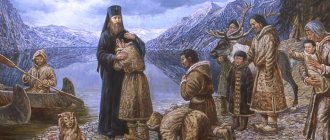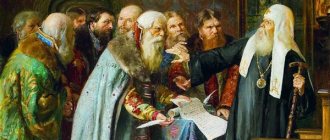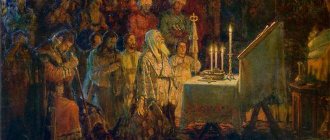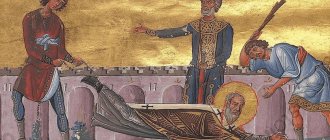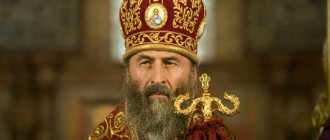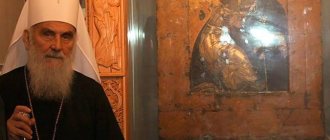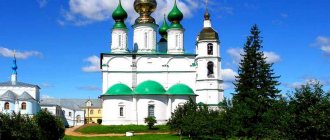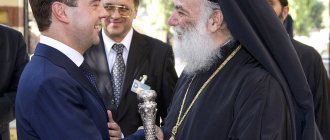Patriarch Filaret was considered by his contemporaries to be a strong-willed person. When he began to engage in public and government activities, Russia was transformed. Known in the world as Fyodor Nikitich Romanov, he became the first representative of the dynasty to bear this particular surname. Moreover, he was destined to become the father of the first tsar from the Romanov family - Mikhail Fedorovich.
However, the role of Patriarch Filaret himself in the history of his homeland also cannot be diminished. What was the life path of the father of the first ruler from the great dynasty of kings? Why was the spiritual path chosen by Fyodor Nikitich against his will?
From today on our website worldofhistory.ru and on the Yandex.Zen channel “World of History” a series of articles dedicated to the Romanov family from the very beginning of their reign begins. All the rulers, their wives, mistresses and lovers, children, grandchildren and various events - we will have all this.
Romanov's early years
Fyodor Nikitich was born approximately in 1553 or 1554 (exact data has not been preserved). From an early age he showed a lively mind, an interest in various sciences and social life. In his youth, Romanov did not even think about taking holy orders and tonsure.
On the contrary, Fyodor Nikitich was famous as a famous dandy. In his book dedicated to the Romanovs, historian Nikolai Kostomarov told a funny moment. When famous tailors in Moscow sewed a suit for someone, and it looked great on the customer, the master would compliment: “Now you are a perfect Fedor Nikitich.”
As you can see, the name Romanov was even used in a certain general sense, meaning dandy and handsome. Fyodor Nikitich was one of the most influential and brilliant Moscow boyars. In 1593, he already became the governor of Pskov, later received the rank of governor and became one of the leaders of the royal duma.
Repin Ilya Efimovich “Portrait of Fyodor Nikitich Romanov”
Typography
Filaret paid great attention to printing books and correcting errors in the texts of ancient manuscripts. In 1620, he resumed the work of the Moscow printing house on Nikolskaya Street, founded by Ivan the Terrible in 1553. He established a “correction room” - a special room for reference workers (editors of ancient manuscripts). Filaret especially monitored the “purity” of ancient texts, for which the most educated reference specialists were involved, who were obliged to compare the texts with ancient Slavic manuscripts, and sometimes resorted to Greek sources. Corrected books were distributed to monasteries, churches and trading stores at cost, without markup. Books were sent to Siberia free of charge. In total, the Moscow printing house under Filaret published many editions of monthly menyas and a number of liturgical books.
Confrontation between Romanov and Godunov
It would seem that Fyodor Nikita’s path was quite obvious, but fate had many trials in store for him. It was Romanov who became the main rival of Boris Godunov in the struggle for the throne. This was the reason for the exile of Fyodor Nikitich and his wife after Godunov came to power.
History has preserved information about the machinations of Boris Godunov and his associates. With the help of treasurer Bartenev and his people, Romanov’s rival planted poisoned roots in Fyodor Nikitich’s house. Soon the mansions are stormed, where poisonous plants are discovered. Such a find was regarded as an attempt at a conspiracy against the tsar, and therefore Romanov fell into disgrace.
Forced tonsure as a monk turned Romanov into Patriarch Filaret, and his wife, Ksenia Shestova, into nun Martha. Despite the fact that Romanov initially did not plan to connect his life with the spiritual direction, he took the rank he received with full responsibility.
Tyutryumov Nikanor Leontievich “Filaret, Patriarch of Moscow”
Separation from his wife and children, long years of exile in the north in the Siysky monastery did not break, but strengthened the spirit of the patriarch. His opponents were confident that Romanov would spend the rest of his days serving God and praying, without causing trouble for Godunov.
True, Fyodor himself at first was not distinguished by his love for the words of the Gospel, and was very arrogant towards his brother monks. In my opinion, he simply did not give up hope of returning to the world.
Bailiff Bogdan Voeikov, in his reports for Godunov, writes about Patriarch Filaret:
“Not according to the monastic rank, he always laughs for unknown reasons and talks about worldly life, about birds of falcon and about dogs, how he lived in the world, and is cruel to the elders.”
Portrait of Patriarch Filaret from the royal titular book
Personal life
Fyodor Romanov had a reputation as a womanizer , wasting his life in carnal pleasures. Kutila remained a bachelor for a long time, which was a rare occurrence in those days. When he got married in 1590, it caused a lot of gossip. His wife was 20-year-old Ksenia Shestova . She was the daughter of Kostroma resident Ivan Vasilyevich, who served in the “chosen thousand” of Ivan the Terrible.
The premarital history of their relationship is shrouded in darkness. It is not clear why they did not woo a beautiful girl with a decent dowry for a long time. After all, at the date of her marriage she was considered an old maid . The groom was at court and occupied a prominent position in the Boyar Duma.
Ksenia Shestova
It seemed strange to contemporaries that the closest relative of Tsar Fyodor Ioannovich set his sights on a noblewoman of an obscure family. Assuming the presence of love between the newlyweds, they were condemned. It was believed that marriages should be arranged by the parents. And love before marriage can only arise through acquaintance, if the girl goes where she shouldn’t. After all, decent unmarried daughters only go to church and then accompanied by relatives.
The conversations soon stopped, and the Romanovs lived amicably. They had 6 children , only Tatiana and Mikhail . The children's health was undermined by the exile. As a result of living in the northern wilderness, the daughter died at age 18 from suspected tuberculosis. The son subsequently became the 1st Tsar in the Romanov dynasty.
Return of Patriarch Filaret
But fate prepared many surprises even for Fyodor Romanov himself. The Time of Troubles became a period of dramatic changes and ups and downs for him. With the end of Godunov's reign, False Dmitry I ascended the throne, declaring his good relations with the royal family. He frees Romanov and his wife and makes Fedor Metropolitan of Rostov.
Patriarch Filaret was captured in Rostov by the Tushins, but even then he declared himself to be a captive, and not a representative of the clergy. However, the fame of his deeds in the spiritual field and his good name did not suffer thanks to his dedication and impeccable reputation even after the fall of the new king and the arrival of False Dmitry II.
Now Fyodor Nikitich was entrusted with a diplomatic mission. Patriarch Filaret headed the embassy going to King Sigismund. The Polish ruler demanded recognition of the capture of Smolensk, but Romanov defended the interests of Rus' without yielding to the Poles. He had to spend almost nine years in captivity.
Autograph of Patriarch of Moscow Filaret (17th century).
Death
Once Filaret of Moscow shared a dream with his confessor, in which his long-dead father ordered to “save” the 19th. Since then, on this day of every month, the Metropolitan received communion and received anyone who asked as a guest.
Filaret of Moscow in old age
Two days before his death, Elder Filaret suddenly felt a surge of strength and realized that this was a sign - usually old people are filled with vigor before their death. On Sunday, November 19, 1867, the Metropolitan held a liturgy in the Trinity Metochion, then talked with visitors and retired to his office to work.
The assistant, without waiting for the priest who was late for lunch, went to remind him about the beginning of the meal and found him kneeling. Filaret was no longer able to speak, and died a couple of hours later. Another version of the legend says that a man died near the washbasin and was found already dead.
Relics of Philaret of Moscow
The relics of St. Philaret were buried in the Trinity-Sergius Lavra, where they rested for 140 years along with the remains of St. Innocent of Moscow. In 2004, the priest’s will was violated by transferring the relics to the Church of the Savior in the capital of Russia.
Fyodor Romanov - Tsar?
Romanov was released in 1619, when he was finally able to see his grown-up son, who became the Russian Tsar. Amazingly, the authority of his father, who at that time was still a prisoner of the Poles, played a significant role in the election of Mikhail Fedorovich to reign.
The young king was incredibly happy about his father's return. Some of the responsibilities of the ruler had already been taken over by the nun Martha, Michael’s mother. Now Fyodor Nikitich has come to the rescue.
Some historians call Patriarch Filaret “Russian Richelieu.” The elderly Fyodor Romanov established himself as an energetic statesman, superior in knowledge and experience to the young Tsar. It seemed that Patriarch Filaret had abandoned his previous ambitions and became an absolute ally and support for his son.
But was it all that simple? One of the most important mysteries of this person was the portrait found in the Kolomna Palace in 1863. On it the patriarch appears in royal vestments with the attributes of state power. Below is the signature: “Tsar Fyodor Nikitich.”
The sculpture of Patriarch Filaret, Tsar Michael and his mother Martha was made for a monument on the occasion of the 300th anniversary of the Romanov dynasty
The mystery of this portrait has never been solved. Perhaps Filaret saw himself as a ruler even under his reigning son. But, it seems to me, this picture is a reference to earlier times, to the period of rivalry with Godunov. This portrait could reflect the hopes of Fyodor Romanov to become the full-fledged Tsar of Russia. He did not officially become a sovereign, but he successfully realized many of his dreams.
Patriarch Filaret died in 1633, having lived a long life full of trials, ups and downs. Fyodor Nikitich Romanov managed to carry out reforms that significantly changed the church structure. Now it resembled the structure of the sovereign's court. He endowed the patriarchs with greater rights, but also increased the responsibility of holders of clergy. He had a rare gift - the ability to combine government activities and solving issues of the Orthodox Church.
Troubles
The participation of the future patriarch in the events of the Time of Troubles was very active, and not always of his own free will.
At first, False Dmitry the First came to power. Boris Godunov died, Fyodor was killed, False Dmitry sat on the throne, but the throne under him, figuratively speaking, was shaking. In order to somehow strengthen his position in the Time of Troubles, False Dmitry tried to rely on those who were in disgrace during the time of Godunov. One of these individuals was Filaret.
False Dmitry releases Philaret, who was kept under supervision in the monastery, and appoints him Metropolitan of Rostov.
The power of the former defrocked Grishka Otrepyev did not last long. After the inglorious and terrible death of the impostor tsar, False Dmitry II appears on the political arena. Filaret becomes patriarch. But the second impostor also dies.
Filaret participated in events that are reflected in all history textbooks. He took the side of those representatives of the boyar elite who believed that it was possible to place a foreigner on the Russian throne. Probably, in this way they tried to maintain their own positions at the top of the government. Filaret initially supported this point of view, but then learned that the Polish prince Sigismund III, scheduled for the role of Russian sovereign, would remain a Catholic. If you follow the logic of the chroniclers of that time, it turns out that Filaret was not against the Pole Tsar, as long as he changed his faith to Orthodox. Most likely, this was just a clever move on Filaret’s part: it is unlikely that he seriously agreed to the actual subordination of the Russian state to the Poles, whose encroachments he only managed to get rid of.
The result of Filaret’s decisive refusal to sign a document supporting the Polish pretender to the Russian throne was the captivity of the metropolitan.
The statesman remained in captivity until 1619. He managed to return to Russia 6 years after the election of his son Mikhail to the kingdom.
Church governance reforms
Filaret's Cowl
Filaret sought to organize the administration of the patriarchal court on the model of the sovereign's court. A new class of patriarchal nobles and boyar children was created, who received local salaries for their service.
On May 20, 1625, Filaret, as a sovereign, issued a royal decree, according to which the patriarch received the right to judge and instruct the clergy and peasant population of the patriarchal region in all matters except tatba (theft) and robbery. Thus, under Filaret, the patriarchal region finally took shape as a state within a state. Its management has become streamlined, but has also become significantly more complex; it was concentrated in patriarchal orders.
- Judicial, or discharge - was in charge of judicial affairs;
- Church - was in charge of the affairs of the church deanery;
- State - in charge of collections from the clergy;
- Palace - managed the economy of the patriarchal estates;
In each order there was a patriarchal boyar with clerks and clerks. The Patriarch personally received and signed the reports. Filaret also carried out a complete inventory of church and monastery property and a review of the charters issued to monasteries with lands transferred for their use.
In 1620, a new Tobolsk diocese was opened.
In 1625, the patriarch was given a part of the Lord's robe as a gift from the Persian Shah Abbas I, which was placed in the ark in the Assumption Cathedral. This Orthodox shrine is still kept in the Cathedral of Christ the Savior.
Sources
- Acts of the Siysk Monastery. - Arkhangelsk: Arkhangelsk Diocesan Church-Archaeological Committee, 1913. - T. 1: Letters of Patriarch Philaret (1613-1633). — 116 p.
- Discharges in 1585 // Ancient Russian vivliophys. — Ed. 2nd. - M.: In the printing house of the Printing Company, 1790. - T. 14. - P. 462–485. — 496 p.
- Discharges in 1586 // Ancient Russian vivliophys. — Ed. 2nd. - M.: In the printing house of the Printing Company, 1790. - T. 14. - P. 465–496. — 496 p.
- The rite of naming and installation on the patriarchal Russian throne of His Eminence Filaret Nikitich, Metropolitan of Rostov // Ancient Russian Vivliofika. — Ed. 2nd. - M.: In the printing house of the Printing Company, 1788. - T. 6. - P. 125–162. — 506 p.
Notes
- Historical acts collected and published by the Archaeographic Commission. - St. Petersburg, 1841. - No. 184. T. I. - P. 347.
- ↑ 123
Kostomarov, 1912, p. 588. - ↑ 1234
RBS, 1901, p. 94. - ↑ 12345678
Solodkin, 2004, p. 161. - ESBE, 1902, p. 735.
- Kostomarov, 1912, p. 589.
- Discharges, 1585, 1790, p. 484.
- ↑ 1234
ESBE, 1902, p. 736. - The family was distinguished by special piety. This is confirmed by folk art, in which Fyodor Nikitich’s father Nikita Romanovich is called a “good boyar”, “glorious uncle” (see: Songs collected by P.V. Rybnikov. - Part 1. - pp. 66-67.)
- Wed. from Patriarch Hermogenes: “And those who are taken captive, like Metropolitan Philaret and others, not of their own will, but out of need, and do not stand by the Christian law, and do not shed the blood of their Orthodox brethren... we do not blame such people, but we also pray for them of God, great power, so that the Lord would turn away His righteous anger from them and from us and give useful things to them and to us according to His great mercy” (Acts of the Archaeographic Expedition. - Vol. 2. 1598-1613. - St. Petersburg: Type. II departments of the Own E.I.V. Chancellery, 1836. - No. 169. - P. 288-289.
- V. Korsakova.
Lugovskoy, Flor Iudich // Russian Biographical Dictionary: in 25 volumes. - SPb.-M., 1896-1918. - ASM, 1913, p. 33-34.
- Solodkin, 2004, p. 165.
- Oparina T.A. Ivan Nasedka and the polemical theology of the Kyiv metropolis. — Novosibirsk: Science. Sib. Enterprise RAS, 1998. pp. 46-74
- Local cathedral 1620 Moscow
- Kartashev A.V. Essays on the history of the Russian Church. Volume 2
- Metropolitan Macarius (Bulgakov). History of the Russian Church. Part 5. Chapter 3
Literature
- Bogolyubsky M. S., prot.
Moscow hierarchy. Patriarchs. - M., 1895. - P. 16-18. - Kizevetter A. A.
Filaret, Russian Patriarch // Encyclopedic Dictionary of Brockhaus and Efron: in 86 volumes (82 volumes and 4 additional). - St. Petersburg, 1902. - T. XXXVa. - Kostomarov N.I.
Filaret Nikitich Romanov // Russian history in the biographies of its main figures. — Ed. 6th. - SPb.: Type. M. M. Stasyulevich, 1912. - T. 1. - P. 588–594. — 594 p. - N. S.
Filaret Nikitich Romanov // Government Bulletin. - March 28, 1913. - No. 70. - P. 2-3. - Smirnov A.
His Holiness Patriarch Filaret Nikitich of Moscow and All Russia. - M., 1874. Parts I-2. (in “Readings of the Society of Lovers of Spiritual Enlightenment,” 1873-74). - Platonov S. F.
Filaret (Romanov-Yuryev) // Russian biographical dictionary: in 25 volumes. - St. Petersburg, 1901. - T. 21: Faber - Tsyavlovsky. - Solodkin Ya. G.
The emergence of the New Chronicler and Patriarch Filaret // Ancient Russia. Questions of medieval studies. - 2006. - No. 2 (24). — P. 55-60. - Solodkin Ya. G.
Filaret (in the world Fyodor Nikitich Romanov-Yuryev) // Dictionary of scribes and bookishness of Ancient Russia. - St. Petersburg: Nauka, 2004. - T. 3/4. — pp. 161–168. — 889 p. — 1500 copies. - Filaret // Small encyclopedic dictionary of Brockhaus and Efron: in 4 volumes - St. Petersburg, 1907-1909.
- Filaret / Ustinova I. A. // Uland - Khvattsev [Electronic resource]. - 2022. - P. 334. - (Big Russian Encyclopedia: [in 35 volumes] / chief editor Yu. S. Osipov; 2004-2017, vol. 33). — ISBN 978-5-85270-370-5.
- Chetyrkin F.V.
Filaret Nikitich, great sovereign and patriarch // Lives of the most holy patriarchs of Moscow and all Russia (1589-1700). - SPb.: Publishing house. Russian-Slavic Book Warehouse, 1893. - pp. 29–41. — 97 s.
